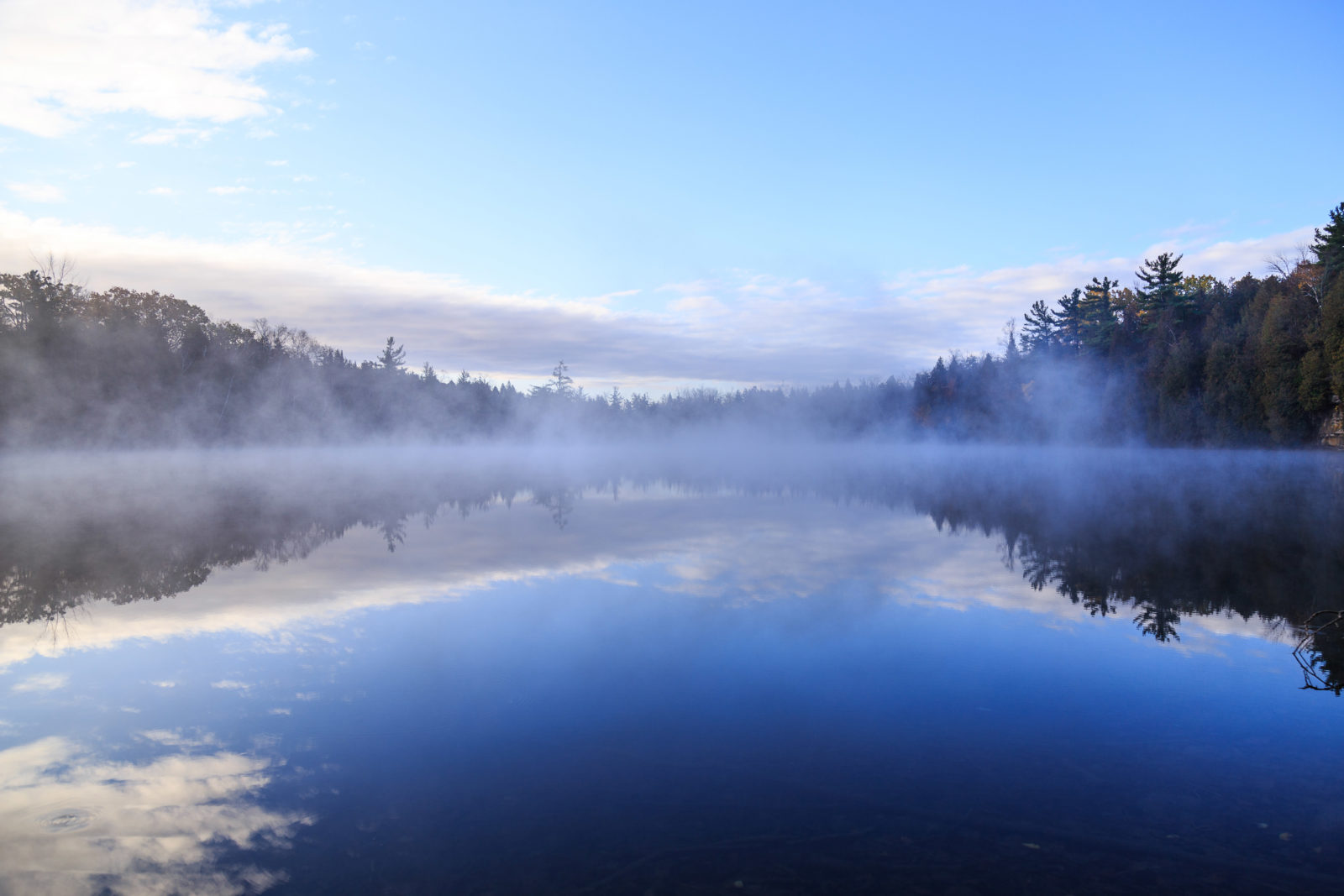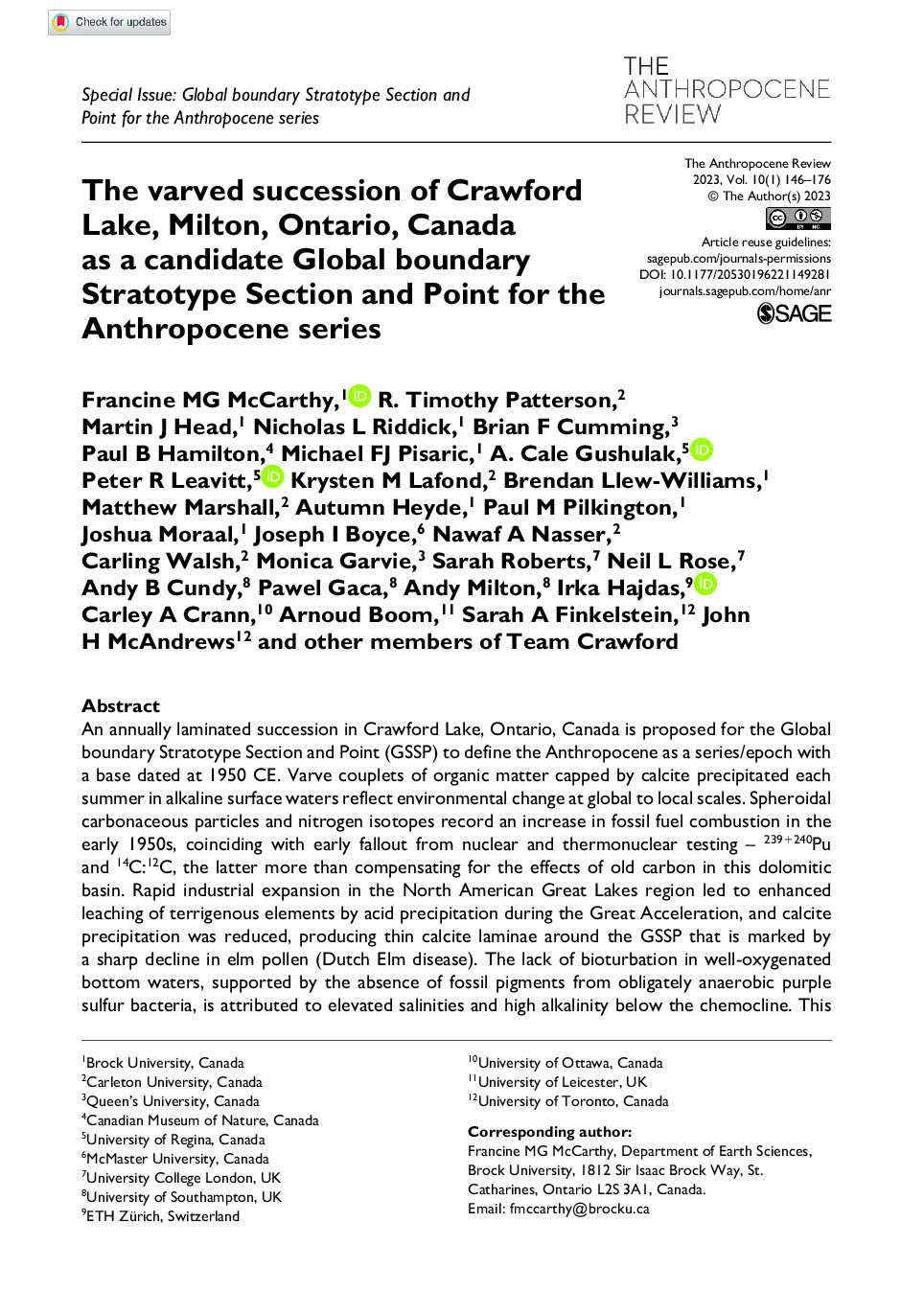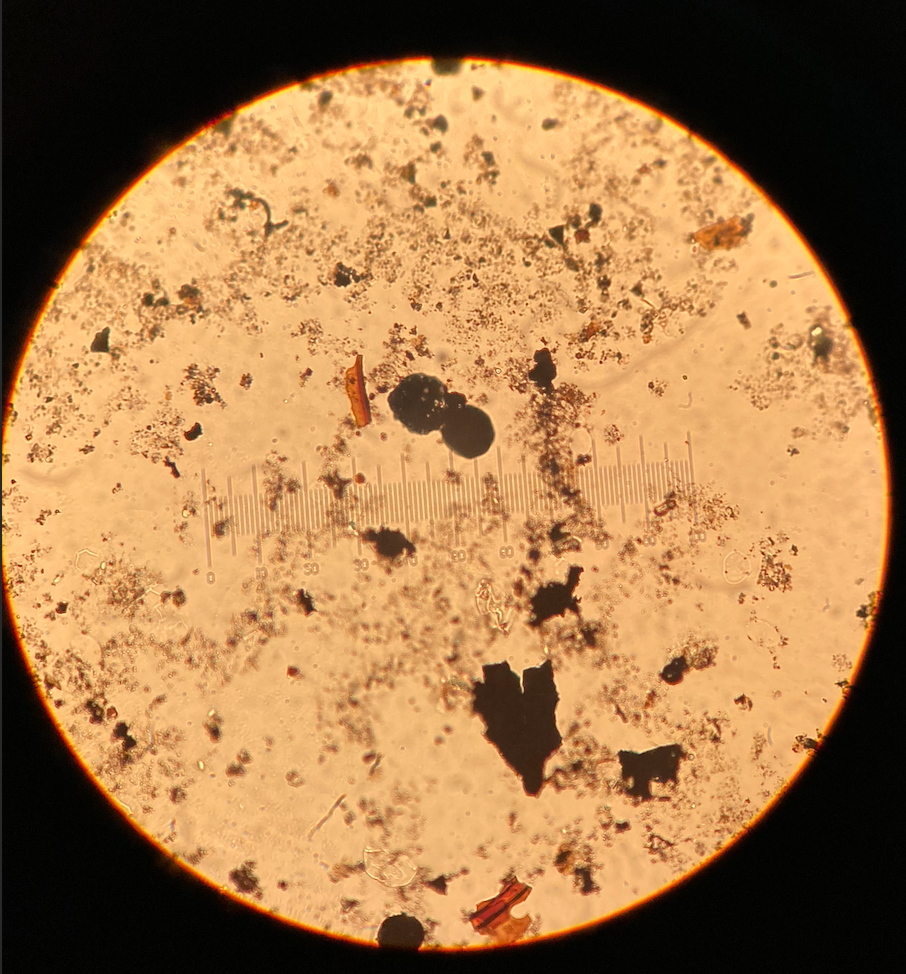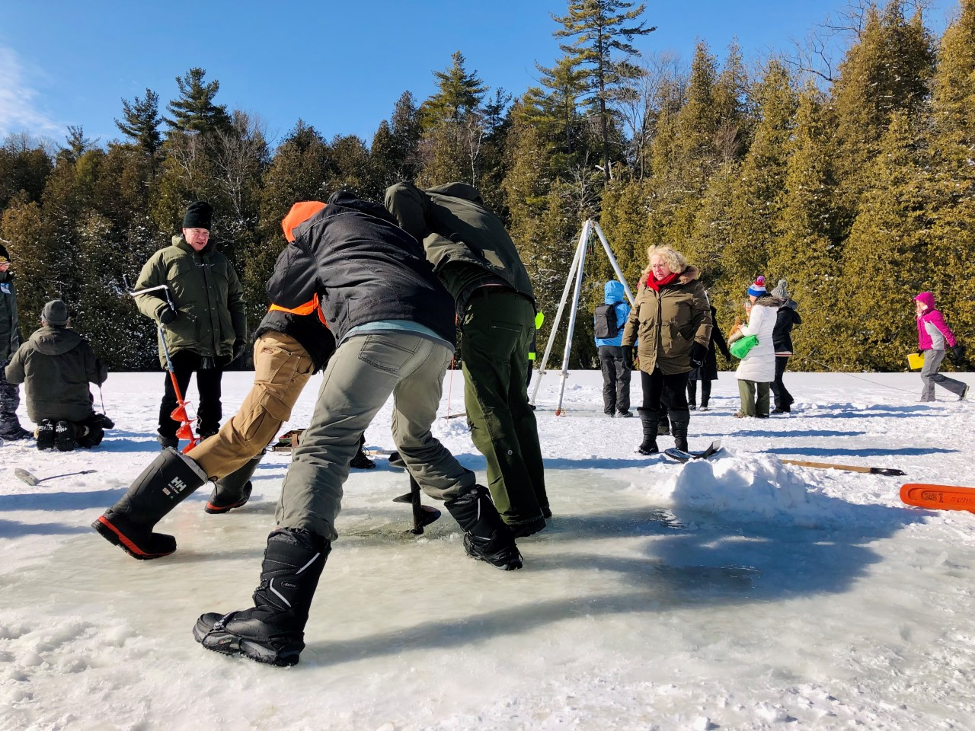Crawford Lake, Canada

Site Introduction
Crawford Lake is a small, deep lake within a protected conservation area in Southern Ontario, Canada as part of a UNESCO Biosphere Reserve. It is surrounded by young cedar-dominated woodland (the old-growth forest was intensely logged by colonizers in the mid-nineteenth century) with numerous recreational hiking trails and it was the site of Indigenous agricultural settlement, with two distinct periods of agricultural activity around the middle of the last millennium. The lake is situated in a karstic1 limestone landscape and fills a sinkhole created by the dissolution of underground rock. Because of the lake’s great depth (twenty-four meters) relative to its surface area (2.4 hectares), it is what is known as a meromictic2 lake: the bottom layer of water does not mix with the upper layers and is therefore isolated from the atmosphere, preventing disturbance of the lakebed.
Crawford Lake has been a site of scientific interest for decades. In the early 1970s, pollen of corn and other cultigens was discovered in lake sediments dating to the late 13th century, and archaeologists began excavating the surrounding lands in 1972 for evidence of settlement. Since then, remains of Indigenous longhouses (and more than 10,000 cultural objects) have been found approximately 200 meters from the lake; the longhouses were occupied by several hundred Attawonderon or Wendat people over a 218-year period. Three longhouses have now been reconstructed at the site and serve as educational and exhibition spaces, and they remain culturally significant to Indigenous communities.
The lake is in a rural area, four kilometers from the small community of Campbellville, and thirty kilometers from the industrial city of Hamilton, which has been a major steel manufacturing center since the early twentieth century. The Crawford Lake Conservation Area has been administered by Conservation Halton since 1969, giving it protected status. The organization has recently applied for funding to build a new educational visitor center and to otherwise improve this important site. Crawford Lake may also be renamed in the Wyandot language, to reflect its past as an Indigenous settlement.
Location of the Core
Crawford Lake is a meromictic lake, meaning that the dense bottom layer of water (which is called the monimolimnion) does not mix with—and has different water chemistry to—the less dense upper layers (the mixolimnion). The isolated bottom layer of water remains undisturbed, enabling the accumulation of clearly laminated varves3 which record precise information about the time during which they were deposited. The abundant calcium and carbonate ions dissolved from the surrounding 430 million year old limestones crystallize in warm surface waters, capping the dark organic-rich sediments every summer, allowing them to record the regional climate and lake ecosystem each year, much like tree rings. These varves preserve a variety of material, including radionuclides,4 spheroidal carbonaceous particles,5 SCPs/ fly ash, various types of algae (diatoms, chrysophytes, and dinoflagellates), cyanobacteria, testate amoebae, and other microorganisms (rotifers, cladocerans, and ostracods). These traces provide evidence of past environmental conditions, recording changes in atmospheric composition, pH,6 levels, carbon cycling, and climate.
Usually, the bottom layer of a meromictic lake is anoxic7 (dead zone with bacteria), The discovery of oxygen-demanding organisms in the monimolimnion and in lakebed sediments proved that Crawford Lake is exceptional: the monimolimnion is fed by oxygenated groundwater. This phenomenon is important for geologists, as such conditions should help ensure that any plutonium from mid-century nuclear bombs will remain in the sediment layer in which it was deposited (no remobilization).
At the current rate of sedimentation, it will take 30,000 years for the lake to fill in, meaning it has the potential to create an Earth archive that extends into the far future.
Meromictic layers of Crawford Lake. Higher density below the chemocline prevents mixing of the monimolimnion with the overlying mixolimnion. Oxygenated groundwater feeds the monimolimnion. Image by Francine McCarthy © All Rights Reserved
The Core and Results
The Crawford Lake core tells a story of anthropogenic impacts from Indigenous settlements in the thirteenth to fifteenth centuries, through settler-colonial communities from the mid-nineteenth century, to post-industrial global events beginning in the mid-twentieth century. The sediments show how local, historical anthropogenic impacts can be differentiated from those that mark the proposed geological time interval of the Anthropocene, which is concerned with a globally synchronous, broad-scale transformation in Earth’s history.
The core is characterized by alternating layers of dark organic matter (deposited in winter) and light calcite (deposited in summer), which record a high-resolution record of changes in the lake ecosystem. The first appearance of maize pollen in the late 13th century provides evidence of Indigenous agricultural activity, coinciding with the first distinct varves, since the increase in nutrients to the lake caused the pH to rise allowing more calcite to crystallize each summer. Farming in the area continued for more than 200 years, recorded by agricultural pollen (mainly maize and sunflower) and fungal spores from crop pathogens (such as corn smut). The agricultural activity also resulted in thicker varves (as more sediment was deposited), while increased algae production from a higher nutrient load resulted in lake eutrophication.8
In the late 15th century, the Indigenous village was abandoned, and, without the agricultural input, the varves again become thinner and the calcite layers did not accumulate each summer through the colder period of the Little Ice Age, until the early 19th century when European colonizers arrived. As a result of agriculture and logging (a lumber mill operated by the lake through the late 19th century), thick varves (1–3 millimeters) containing abundant dark-gray charcoal were deposited, and there is evidence of a second phase of increased nutrient input, erosion, and eutrophication.
‘Bomb’ radionuclides such as plutonium-239 and cesium-137 in the varves identify fallout from nuclear weapons in sediments beginning in 1946-47 recording the atomic testing and bombs of 1945, peaking in 1963-64 when the Limited Test Ban on above-ground testing was signed. The “bomb pulse9— the sudden increase of carbon-14 in Earth’s atmosphere caused by hundreds of nuclear bomb tests—is also evident in the sediments of Crawford Lake. Broad-scale global changes are thus preserved alongside broad regional and local anthropogenic impacts. Gaseous and particulate emissions from increased combustion of fossil fuels increase sharply in varves deposited during the early 1950s. These are very thin, particularly the summer calcite component, because the atmosphere pollution caused the pH of surface waters to decrease. The biosphere responded quickly to this change in the hydrosphere as deep-dwelling algae thrived in the clearer waters where more light penetrated, not reflected by as many calcite crystals during the growing season. The change in the geosphere is obvious as a colour change and geochemical analysis confirms the influx of metals attributed to uncontrolled emissions during the Great Acceleration.
Collection and Analysis
An eighty-nine-centimeter-long sediment core was one of several collected from the deepest point of Crawford Lake in February 2019, using the freeze coring method, which allows the varved succession to be recovered intact. Because the varves deform slightly during slicing, the core cannot simply be cut straight through; rather, precise scalpel work is required that follows the curved lines of the varves. The freeze cores were subsampled by hand at Carleton University, Ottawa, and sent to laboratories where analyses targeted indicators of environmental change, including diatom10 and scaled chrysophyte11 assemblages, fossil pigments, non-pollen palynomorphs,12 plutonium, radiocarbon, radionuclide dating, sediment chemistry, spheroidal carbonaceous particles (SCPs),13 stable isotopes, and varve imagery. Other sampling was performed to characterize present lake conditions, including seasonal water chemistry, hydrological measurements, and biological activity.
Unfortunately, only very thin rinds of sediment are retrieved by freeze cores (especially at the upper portion of the core), which provided relatively small volumes of material for multiple laboratory analyses. Because of this, several more cores were extracted in February 2022.
SCP analysis of the Crawford Lake core. Image by Sarah Roberts © All Rights Reserved
The Research Team
Team Crawford consists of over forty researchers from nine Canadian institutions under the coordination of Francine McCarthy at Brock University, St. Catharines, Ontario, whose MSc supervisor Jock McAndrews (former Curator of Botany at the Royal Ontario Museum, Toronto) initiated research on the varved sediments of Crawford Lake in the 1960s. Brock University has a long history of research at Crawford Lake, beginning with Mike Dickman in the 1970s, and McCarthy and students have been studying the varves since 2011, focusing on pollen and non-pollen palynomorphs.
In 2018, Martin Head realized the potential of the undisturbed annual laminations in this lake, protected by Conservation Halton, as a potential Anthropocene GSSP, and two additional coring expeditions were planned to collect further material for analysis to support its candidacy. In 2019, freeze coring and subsequent curation, high-resolution imagery, and subsampling of freeze cores was coordinated by Tim Patterson. Additional “standard” sediment cores were collected by Joe Boyce and Mike Pisaric, providing larger sediment volumes but less precise chronologic resolution than freeze coring; elemental analysis has been performed on these via X-Ray Fluorescence (XRF) scanning at McMaster University.
All sediment cores have been studied for various proxies—including radiocarbon, SCPs, plutonium, and stable isotopes required for assessment by the Anthropocene Working Group (AWG)—at University College London, University of Leicester, and University of Southampton in the UK. Ongoing research forms part of two dissertations in progress (Monica Garvie, Queen’s University, Kingston, Ontario, on siliceous microfossils; Andrea Krueger, Brock University, on algal palynomorphs). Several students have completed theses over the past three years: Krysten Serack, BSc, Carleton University (varve chronology, time series analysis); Matthew Marshall, BSc, Queen’s University, MSc, Carleton University (chrysophyte scales); Emily Farlam-Williams, MSc, Carleton University (diatoms); A. Heyde and B. Llew-Williams, MSc, Brock University (organic and inorganic constituents of varves and preservation). Cale Gushulak (PhD, Queen’s University) undertook diatom analysis on the freeze cores at Queen’s University as a side project during his PhD. Three postdoctoral candidates are also involved with research on the cores: Cale Gushulak, University of Regina (fossil pigments); Nick Riddick, Brock University (sediment geochemistry, fungal palynomorphs); and Nawaf Nasser, Carleton University (supervising core curation and subsampling). Colleagues Brian Cumming (Queen’s University) and Peter Leavitt (University of Regina, Saskatchewan) are analyzing the gravity and percussion cores for lead-210 and fossil pigments.
Colleagues at Conservation Halton and the Royal Ontario Museum have been involved with research at Crawford Lake since the late 1960s. The Canadian Museum of Nature, Ottawa, became involved in 2019 and, through the efforts of Paul Hamilton (a Research Assistant at the museum), has agreed to archive a freeze core face from the deep basin of Crawford Lake at its cryogenic facility, irrespective of the decision of the AWG. These institutions are the primary venues through which the story of Crawford Lake has been, and will continue to be, told, and slides and residues of samples studied to support the candidacy of Crawford Lake’s deep basin succession will be trusted to the Canadian Museum of Nature.
Members of the Crawford Lake team working on the lake, with PI Francine McCarthy and Martin Head (previous Chair of the Subcommission on the Quaternary) looking on. Photograph by Brenna Bartley, courtesy Conservation Halton © All Rights Reserved
Principal investigators (listed alphabetically):
Martin Head, Brock University
Francine McCarthy, Brock University
Tim Patterson, Carleton University
Contributing Scientists/Researchers (listed alphabetically):
Aaron Anderson, Brock University, Algal palynomorph analysis
Stephane Aube, Carleton University, Core subsampling
Brenna Bartley, Conservation Halton, Fieldwork and education
Deirdre Bateson, University of Regina, Stable isotope and pigment analysis
Arnoud Boom, University of Leicester, Stable isotope (C/N) analysis
Max Boreux, Queen’s University, 210Pb radionuclide dating
Joe Boyce, McMaster University, ITRAX core analysis
Uwe Brand, Brock University, Water and sediment chemistry
Soren Brothers, Royal Ontario Museum, Curator
Roslin Chen, University of Ottawa, Core sub-sampling
Scott Cocker, Brock University, Field and lab assistance
Carley Crann, University of Ottawa, Radiocarbon analysis
Brian Cumming, Queen’s University, 210Pb radionuclide dating and siliceous microfossil analysis
Andy Cundy, University of Southampton, Plutonium analysis
Emily Farlam-Williams, Carleton University, Siliceous microfossil analysis
Bill Finlayson, Wilfrid Laurier University, Site and regional archaeology
Monica Garvie, Queen‘s University, Siliceous microfossil analysis
Cale Gushulak, Queen’s University/now University of Regina, Fossil pigment and stable isotope analysis; siliceous microfossil analysis
Paul Hamilton, Canadian Museum of Nature, Freeze core curation
Autumn Heyde, Brock University, Zooplankton and non-palynomorph analysis
Andrea Krueger, Brock University, Algal palynomorph analysis
Brendan Llew-Williams, Brock University, Hydrology and water chemistry
Krysten Lafond (formerly Serack), Carleton University, Varve imagery and analysis
Peter Leavitt, University of Regina, Fossil pigment and stable isotope analysis
Bangyu Liu, Carleton University, Core subsampling
Jock McAndrews, University of Toronto, Lake paleolimnology
Mike MacKinnon, OSPM Solutions, Water and sediment chemistry
Andrew Macumber, Carleton University, Core collection and fieldwork
Matthew Marshall, Queen’s University/now Carleton University, Siliceous microfossil (chrysophytes) analysis
Deborah Metsger, Royal Ontario, Museum Curator
Joshua Moraal, Brock University, field and lab assistant
Sarah Murseli, University of Ottawa, Radiocarbon analysis
Nawaf Nasser, Carleton University, Freeze core sampling and analysis
Anne Nguyen, Carleton University, field assistant
Ben O’Reilly, Conservation Halton, Fieldwork
Ms. Katherine Peacock, Carleton University, Core subsampling
Paul Michael Pilkington, Brock University, Algae analysis
Michael Pisaric, Brock University, Core collection
Eduard Reinhardt, McMaster University, Core collection and fieldwork
Nicholas Riddick, McMaster University/now Brock University, ITRAX core and non-pollen palynomorph analysis
Sarah Roberts, University College London, SCP analysis
Neil Rose, University College London, SCP analysis
Emily (Duanlu) Shi, Carleton University, field assistant
John Smol, Queen’s University, 210Pb radionuclide dating and siliceous microfossil analysis
Riley Steele, McMaster University, Core collection and fieldwork
Catherine Tammaro, TAMMARO ART/ Design, Wendat Elder/ Knowledge Keeper
Joe Viscek, Brock University, Core collection
Carling Walsh, Carleton University, Varve imagery and wavelet analysis
Naomi Weinberg, Carleton University, field assistant


This article is distributed under the terms of the Creative Commons Attribution-NonCommercial 4.0 License (https://creativecommons.org/licenses/by-nc/4.0/) which permits non-commercial use, reproduction and distribution of the work without further permission provided the original work is attributed as specified on the SAGE and Open Access page (https://us.sagepub.com/en-us/nam/open-access-at-sage).
- “Crawford Lake,” Conservation Halton website
Crawford Lake Virtual Tour website
Byrne, Roger and William D. Finlayson. 1998. “Iroquoian agriculture and forest clearance at Crawford Lake, Ontario.” In Finlayson (ed.), Iroquoian Peoples of the Land of Rocks and Water A.D. 1000–1650: A Study in Settlement Archaeology, London Museum Special Publication 1: 94–107.
Dickman, Mike. 1985. “Seasonal Succession and Microlamina Formation in a Meromictic Lake Displaying Varved Sediments.” Sedimentology 32 (1): 109–18. https://doi.org/10.1111/j.1365-3091.1985.tb00495.x.
Ekdahl, Erik J., Jane L. Teranes, Thomas P. Guilderson, Charles L. Turton, John H. McAndrews, Chad A. Wittkop, and Eugene F. Stoermer. 2004. “Prehistorical Record of Cultural Eutrophication from Crawford Lake, Canada.” Geology 32 (9): 745–48. https://doi.org/10.1130/G20496.1.
Gushulak, Cale A.C., Matthew Marshall, Brian F. Cumming, Brendan Llew-Williams, R. Timothy Patterson and Francine MG McCarthy. 2021. “Siliceous Algae Response to the “Great Acceleration” of the Mid-20th Century in Crawford Lake (Ontario, Canada): A Potential Candidate for the Anthropocene GSSP.” The Anthropocene Review, 1–20. https://doi.org/10.1177/20530196211046036.
Krueger, Andrea M. and Francine M.G. McCarthy. 2016. “Great Canadian Lagerstätten 5. Crawford Lake – A Canadian Holocene Lacustrine Konservat-Lagerstätte with Two-Century-Old Viable Dinoflagellate Cysts.” Geoscience Canada 43 (2): 123. https://doi.org/10.12789/geocanj.2016.43.086.
Boyko-Diakonow. 1979. “The laminated sediments of Crawford Lake, Southern Ontario, Canada.” In C. Schluchter (ed.), Moraines and Varves, Rotterdam: A. A. Balkema: 303–7.
McAndrews, John H., and Charles L. Turton. 2010. “Fungal Spores Record Iroquoian and Canadian Agriculture in 2nd Millennium A.D. Sediment of Crawford Lake, Ontario, Canada.” Vegetation History and Archaeobotany19 (5/6): 495–501. https://doi.org/10.1007/s00334-010-0237-3.
McCarthy, Francine M.G. 2022. “Stratigraphy: Finding Global Markers in a Small Canadian Lake.” In J.A. Thomas (ed.), Altered Earth: Getting the Anthropocene Right. Cambridge University Press.
Llew-Williams, Brendan, Francine M.G. McCarthy, Andrea M. Krueger, Nicholas L. Riddick, Michael D. MacKinnon, Krysten M. Lafond, Timothy R. Patterson, Nawaf A. Nasser, Martin J. Head, Michael Pisaric, Kevin Turner, Joseph I. Boyce and Uwe Brand. (accepted). Varve formation in meromictic Crawford Lake, Ontario, Canada: important process for characterizing the Anthropocene epoch. Journal of Paleolimnology.
Lafond, Krysten M., Carling R. Walsh, R. Timothy Patterson, Francine M. G. McCarthy, Brendan M. Llew-Williams, Paul B. Hamilton, Nawaf A. Nasser, and Brian Cumming. 2023. “Influence of Climatic Trends and Cycles on Varve Deposition in Crawford Lake, Ontario, Canada” Geosciences 13, 87. DOI: https://doi.org/10.3390/geosciences13030087
Marshall, Mattew G., Paul B. Hamilton, Krysten M Lafond, Nawaf A. Nasser, Francine M.G. McCarthy and Timothy R. Patterson. 2023. Annual-scale assessment of mid-20th century anthropogenic impacts on the algal ecology of Crawford Lake, Ontario, Canada. PeerJ. DOI: 10.7717/peerj.14847.










